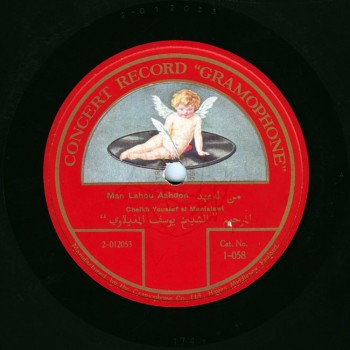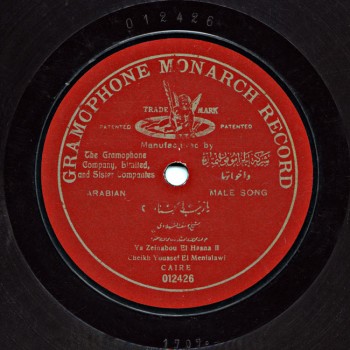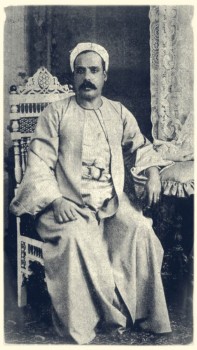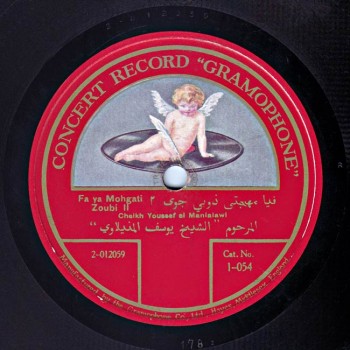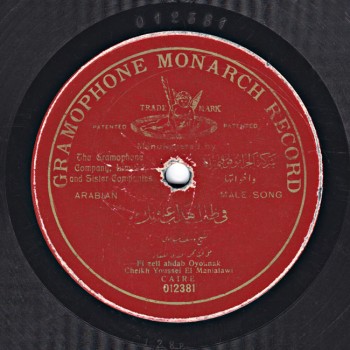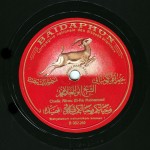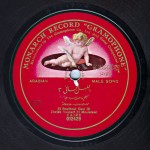The Arab Music Archiving and Research foundation (AMAR), in collaboration with the Sharjah Art Foundation (SAF), presents “Min al-Tārīkh”.
listeners, welcome to a new episode of “Min al-Tārīkh”.
Today, we will resume our discussion about Sheikh Yūsuf al-Manyalāwī.
Let us talk about Sheikh Yūsuf al-Manyalāwī’s mawwāl… Yūsuf al-Manyalāwī was a mawwāl himself…
We chose mawwāl “Fī ẓilli ahdāb ‘uyūnak” whose text was written by Ismā‘īl Bāshā Ṣabrī” and whose melody is improvised to the bayyātī maqām.
Here are the lyrics:
Fī ẓilli ahdāb ‘uyūnak Wardi khaddak āl
W-el-ḥusni mīrāth ‘an Yūsuf Li-waghak āl
W-el-badri wayh el-shumūs Fī ḥusnuhum lak āl
Law ulti li-el-ṣabbi Ūl kull el-milāḥ gundī
We-li-el-gamāl mamlaka Min ghēr mushārik āl
The mawwāl is built on homonymy or on juncture, and offers listeners both the pleasure of enjoying the performer’s beautiful voice, as well as the pleasure to try and solve the mawwāl’s riddle.
Let us analyse the lyrics:
In “Fī ẓilli ahdāb ‘uyūnak, Wardi khaddak āl”: “āl” means “qayyil” derived from “qaylūla” (nap);
In “W-el-ḥusni mīrāth ‘an Yūsuf, Li-waghak āl”: “āl” is the verb “āl /ya’ūl” (to devolve)
In “W-el-badri wayh el-shumūs, Fī ḥusnuhum lak āl”: “āl” means “ahl” (family).
In “We-li-el-gamāl mamlaka, Min ghēr mushārik āl”: “āl” is the verb “qāl / yaqūl” (to say), a result clause.
Decoding the riddles of a mawwāl is called “tazhīr”…
…which we have just done for you… Enjoy…
(♩)
Sheikh Yūsuf al-Manyalāwī was a munshid. Consequently, qaṣīda or literary lyrics writing had a significant place in his artistic journey. I have specified “literary lyrics writing” because he also sang pieces that included takhmīs for example, not only direct poetry. So, qaṣīda here refers to the qaṣīda as a musical form, not as a poetry form.
Exactly, especially the qaṣīda ‘ala al-waḥda, sinces the qaṣīda mursala is often a musical form as well as a poetry form.
(♩) (“Man lahu ‘ahdun bi-nawmin”)
Whereas the texts of qaṣīda ‘ala al-waḥda often include parts that are not qaṣīda, but takhmīs or poetry in between colloquial Arabic and literary Arabic, yet closer to literary Arabic then to colloquial Arabic.
Sheikh Yūsuf al-Manyalāwī went from the biṭāna to the takht, taking along with him the traditions of the biṭāna, the traditions of munshid.
Sufi singing leaves traces that are easily spotted in Sheikh Yūsuf al-Manyalāwī’s performance of qaṣīda.
First, let us look at his repertoire of qaṣīda and where they came from.
The proportion of qaṣīda in his recordings is higher than that of all his contemporaries. He specialized in the performance of qaṣīda, notably the qaṣīda ‘ala al-waḥda…
When was the qaṣīda ‘ala al-waḥda included in the practices of takht music, literary music as we call it?
I think that singing qaṣīda ‘ala al-waḥda in the takht was introduced by munshid who accepted to sing with takht and the idea of converting from religious singing to mundane singing, knowing that the difference between the religious and the mundane is minor or abstract, and that the line separating them is not very clear.
Anyway, the line separating them concerns the lyrics, not to the melody.
How did biṭāna art reach the takht?
I doubt that the qaṣīda ‘ala al-waḥda was the dowry brought by the munshid’s art to this marriage that took place in the last third of the 19th century between mundane tradition and the munshid’s art. Where did the texts come from? When we examine the origin of the poetry texts that were sung, half these qaṣīda were Sufi qaṣīda, whether they are understood through a religious explanation or a mundane explanation.
The characteristic of the texts of ‘Umar Ibn al-Fāriḍ, among other Sufi of the Ayyubid era, then the Mamluk era, then the Ottoman era, is that they can convey both a religious meaning or as love poetry…
(♩) (qaṣīda “Fa-yā muhgatī dhūbī”)
Half this repertoire recorded by Yūsuf al-Manyalāwī consists of the same religious Sufi texts that may also convey a mundane or love poetry meaning. The second half consists of the qaṣīda written in the Abbasid era. I personally doubt that singing those remained constant throughout the centuries and I think that Abbasid poetry was re-discovered, especially that a number of qaṣīda recorded at the beginning of the century are included in Al-Bārūdī’s anthology.
A significant number of anthologies appeared in the late 19th century: chosen works from dīwān (compilations), several poets in one book, a new edition of Abī al-Faraj al-Aṣfahānī’s “Kitāb al-Aghānī” (The Book of Songs), even music books such as “Safīnat al-Mulk” and Al-Khula‘ī’s book that included a few qaṣīda annexed to them. I think they took them from all these sources.
This does not keep these texts from conveying another meaning than the one intended initially.
As an example, I suggest we listen to qaṣīda “Yā Zaynab al-ḥasnā’ ”: Knowing that the Sayyida Zaynab mosque is located in Cairo, those who read this qaṣīda would imagine that it was recited at the Sayyida Zaynab mosque. Thus, that it is a religious qaṣīda. Whereas, in fact, this qaṣīda is mentioned in “Kitāb al-Aghānī” (The Book of Songs), and “Zaynab” bears no relation whatsoever to the Prophet’s granddaughter.
Opposite meanings then: giving a religious aspect to an initially mundane qaṣīda, or a love poetry aspect to Sufi poetry initially meant to convey a Sufi meditative religious aspect.
Which confirms the opacity of the line separating the two concepts.
Let us listen to it, and enjoy the last verse “Hayhāt minki al-‘amalu al-aryabu” in particular. “Al-aryabu” … beautiful…
… beautiful …
(♩)
Dear listeners,
We have reached the end of our episode about Sheikh Yūsuf al-Manyalāwī.
We will meet again in a new episode of “Min al-Tārīkh” to resume our discussion about him.
“Min al-Tārīkh” is brought to you by Mustafa Said.
- 221 – Zakariyya Ahmed – 12 (1/9/2022)
- 220 – Zakariyya Ahmed – 11 (1/9/2022)
- 219 – Zakariyya Ahmed – 10 (11/25/2021)
- 218 – Zakariyya Ahmed – 9 (10/26/2021)
- 217 – Zakariyya Ahmed – 8 (9/24/2021)
- 216 – Zakariyya Ahmed – 7 (9/4/2021)
- 215 – Zakariyya Ahmed – 6 (8/28/2021)
- 214 – Zakariyya Ahmed – 5 (8/6/2021)
- 213 – Zakariyya Ahmed – 4 (6/26/2021)
- 212 – Zakariyya Ahmed – 3 (5/27/2021)
- 211 – Zakariyya Ahmed – 2 (5/1/2021)
- 210 – Zakariyya Ahmed – 1 (4/28/2021)
- 209 – W-al-Lāhi lā astaṭī‘u ṣaddak 2 (4/6/2017)
- 208 – W-al-Lāhi lā astaṭī‘u ṣaddak 1 (3/30/2017)
- 207 – Bashraf qarah baṭāq 7 (3/23/2017)

